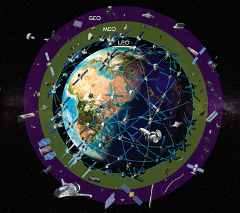Fundamentals of Space Domain Awareness

Instructed by Dr. Wiley Larson and Ms. Pam Magee
- This is the ONLY course that provides complete coverage of Space Domain Awareness (SDA)—necessary capabilities for SDA operations, challenges and problems, strategy and tactics, space object detection, tracking, characterization and identification, overall data and information flow and decision-making.
- All students will receive an AIAA Certificate of Completion at the end of the course
OVERVIEW
This 10-Hour virtual course provides an overview of Space Domain Awareness (SDA) that is focused on the actionable knowledge required to predict, avoid, deter, operate through, recover from, and attribute cause to losing or degrading space capabilities and services. A major purpose for SDA is to provide decision makers with a quantifiable and timely body of evidence of behaviors attributable to specific space threats and hazards. SDA encompasses all activities of information tasking—collecting, fusing, exploiting, quantifying, and extracting—that concludes with identifying and predicting credible threats and hazards.
SDA includes collecting raw observables, identifying physical states and parameters (like orbit, attitude, size and shape) determining functional characteristics (such as active vs. passive, thrust capacity, payloads), inferring mission objectives (such as communications, weather), identifying behaviors, and predicting credible threats and hazards.
LEARNING OBJECTIVES
At the end of this short course, you will:
- Know and apply Space Domain Awareness (SDA) philosophies, tools and techniques
- Understand the value chain for SDA and what government and industry stakeholders need
- Describe the overall purpose of space domain awareness relative to space situational awareness and space traffic management
- Understand and apply the strategy and tactics of SDA
- Explain the elements of the space environment and their effect on objects in space
- Describe object motion, key events and object behavior in space
- Describe what it means to characterize objects and identify space objects
- Apply a space mission design process to create a system for on-orbit sensing of objects
AUDIENCE
This course is of particular interest to space system operators, system developers, managers and administrators. Anyone interested in space situational awareness, space traffic management and/or space domain awareness will find the course and course materials invaluable. This course will be exceptionally useful to space situational awareness professionals, space domain awareness analysts and designers, especially those interested in SDA sensors, data, data flow, data fusion and data sharing.
COURSE INFORMATION
Type of Course: Instructor-Led Short Course
Course Level: Fundamentals
Course Length: 1 day
AIAA CEU's available: Yes
For European Students, please see the offering November 6 - 7.
- Applications, Challenges, Implications, and Definitions for Space Domain Awareness
- Key Questions About Space Objects and How to Find the Answers
- Stakeholders and Wake-up Calls
- Strategy and Tactics for SDA
- SDA Value Chain and Market Assessment
- Space Environment and its Impact on Space Objects and SDA
- Orbit Design and Applications with the Restricted Two-Body Problem and Perturbations
- Conjunction Assessment Risk Analysis
- Sensors and Measurements
- Space Domain Information Fusion Model
- Data Processing and Catalog Update
- On-orbit Sensing with End-to-End Case Study
- Hands-on Exercise
- The course lectures will be delivered via Zoom. You can test your connection here: https://zoom.us/test
- Classes will not be recorded so live attendance is necessary.
- Each registrant will receive a complete set of course notes with copies of all slides used in the presentations.
- No part of these materials may be reproduced, distributed, or transmitted, unless for course participants. All rights reserved.
- Between lectures, the instructors will be available via email for technical questions and comments.
- The SDA course is based in great part on the new eBook, “Space Domain Awareness,” which is not provided as part of this course, but is available for purchase at www.spacetechnologyseries.com
Lead Instructor
Dr. Wiley Larson is an experienced leader in space-related development, operations, education and training with 36 years of contributions in Government and industry space systems. He served as spacecraft systems engineer, spacecraft launch controller, flight test engineer, program and project manager, Associate Professor at the Air Force Academy, and Professor at the Technical University of Delft, Netherlands. Wiley is currently the Managing Editor of the Space Technology Series that includes 25+ books focused on all aspects of space systems engineering and project management. Dr. Larson and his team recently completed a six-year effort to develop the highly acclaimed book, Space Domain Awareness.
Pam Magee, co-editor of “Space Domain Awareness” is the co-instructor.
Pam Magee is the Director of Online Learning for TSTI, an adjunct professor for the Space Systems Engineering Master’s program at Stevens Institute of Technology and an assistant editor for McGraw-Hill’s Space Technology Series. She is an author and editor of the recently published Space Domain Awareness textbook and the Aerospace Science and Understanding Space texts. She earned a BS in Astronautical Engineering from the U.S. Air Force Academy and an MS in Aerospace Engineering from the University of Tennessee. She was an Assistant Professor of Astronautics at the U.S. Air Force Academy, an instructor at the National Security Space and has 28 years of teaching and aerospace experience.
AIAA Training Links
For information, group discounts,
and private course pricing, contact:
Lisa Le, Education Specialist (lisal@aiaa.org)
